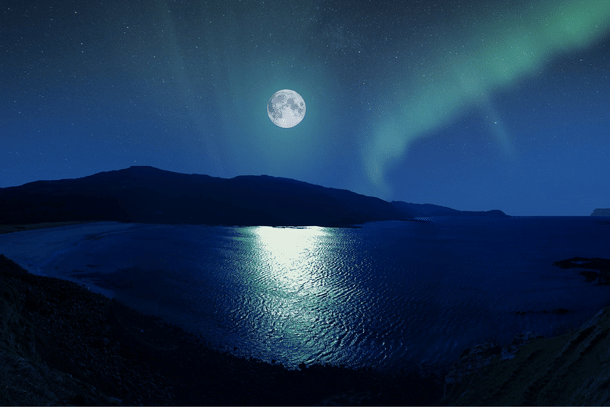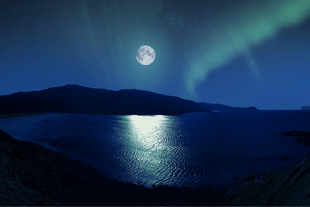Culture
Sharad Poornima Special: Goddess At The Centre Of The Moon Orb
Aravindan Neelakandan
Oct 16, 2024, 08:32 PM | Updated Oct 18, 2024, 04:17 PM IST
Save & read from anywhere!
Bookmark stories for easy access on any device or the Swarajya app.


Serfoji II (1777-1832), the last Maratha ruler of Thanjavur, was a figure of remarkably diverse confluences.
Embracing the scientific ferment of the West through his missionary education, he commissioned what might be considered the first popular science document aimed at disseminating science into the society – in this case the heliocentric theory.
This work, Devendra Kuravanji, adopted the vibrant oral-poetic tradition of the people to bring "Huna Siddhanta"—European astronomy—to the Indian masses.
Within this commissioned piece, Indrani, the celestial queen, beseeches a cosmic nomad to reveal the secrets of the spherical Earth, its majestic mountains and flowing rivers, and the cosmic dance between the Earth and the Sun. Of course she is informed that the earth moves around the sun and the sun rotates on its own axis – not going around any of the planets.
Interestingly, oral traditions depict Serfoji II in a clash with the mystic Subramanya Iyer over the appearance of the full moon. While Wikipedia attributes this encounter to Serfoji I, historical accounts suggest Subramanya Iyer was a contemporary of Serfoji II.
Legend recounts that Iyer, immersed in deep meditation within the shrine of Goddess Abirami at the revered Amritakadeswarar Temple in Thirukadaiyur, was interrupted by the king, who, having just completed a sacred bath in the sea following the New Moon, inquired about the current lunar phase. Lost in the divine effulgence of the Goddess, Iyer proclaimed it to be the full moon. The king, believing Iyer to be a lunatic, departed.
Upon emerging from his trance, Iyer, learning of the king's judgment, erupted in hymns of praise to the Goddess, each verse seamlessly flowing into the next—a poetic form known as Anthaathi.
That very night, the king experienced a vision of the Goddess's earring transforming into the full moon, illuminating the night sky. Humbled and enlightened, the king sought out Iyer and bowed before him. From that day forward, Subramanya Iyer of the Kausika Gotra became known as Abirami Pattar, the devotee of Abirami.
This tradition, passed down through generations, perhaps contains as its kernel a profound truth—the eternal dance between the physical sciences and the science of the Self. The symbolism and sublime expressions of the science of Self cannot be confined to the rigid framework of a naive physical reality.
Perhaps the king, through his encounter with the mystic Abirami Pattar, was guided towards this realisation. Sure enough Serfoji-II was a man of wisdom and discrimination. Perhaps the Abrirami Pattar incident shows that while the king made heliocentric theory and European knowledge of world geography taught in schools, he was made aware of the cosmological vision of Hindu spirituality and its inner significance, so that it would not be discarded as outdated.
In the case of medical sciences, the king had an open approach of synthesis of Western medical systems with Indian medical systems.
The well-known Zen adage speaks of the finger pointing to the moon. In the richness of Hindu Goddess traditions, the moon itself becomes a celestial guide, beckoning towards a realisation far deeper and more enchanting than the mere physicality of the lunar orb.
With this in heart, let us look into the Name 240 in Sri Lalita Sahasranama: Chandra-Mandala-Madhyaga. She who is in the Centre of the Lunar Disc – very clearly it is not the physical moon.
Sure enough Bhaskara Raya one of the most authoritative commentators of Sri Lalita Sahasranama identifies this moon with the final full realisation of Kundalini movement: ‘Kundalini breaks through the moon in the pericarp of the thousand petalled lotus.’
This lunar mandala is said to be with all its phases and is in full completion. There is no waning or waxing. This moon in the thousand-petalled lotus flowering of kundalini is also the very form of Sri Yantra. This is considered more than symbolic and as is with most elements of Shaktic tradition, a reality that can be experienced spiritually.
She is the moon at the centre of the thousand-petalled lotus. She as the very movement reaches the thousand-petalled lotus and unites with Shiva in its centre, which is Chandra-Mandala.
As every Indian knows in the popular vocabulary, both religious and literary, the pan-Indian word 'Soma' means the moon and it also relates to mind. Many consider this a later development. Yet this relates to the Vedic imagery itself. When discussing the evolution of Soma imagery from Vedic to Puranic times, Sri Aurobindo stresses a continuity. He says:
Soma, the plant which yielded the mystic wine for the Vedic sacrifice, has become not only the God of the moon, but manifests himself as mind in the human being. These evolutions suppose some period, posterior to the early material worship or superior Pantheistic Animism attributed to the Vedas and prior to the developed Puranic mythology, in which the gods became invested with deeper psychological functions, a period which may well have been the Age of the Mysteries. As things stand, a gap is left or else has been created by our exclusive preoccupation with the naturalistic element in the religion of the Vedic Rishis. I suggest that the gulf is of our own creation and does not really exist in the ancient sacred writings.The Secret of the Vedas, p.7
In his commentary on the name ‘Chandra Mandala Madhyaga’, Bhaskara Raya provides an extraordinary validation for this statement of Sri Aurobindo, when he quotes Lord Shiva saying to Goddess Parvati, in Shiva Purana that He is at the head of Agni just as She is at the head of Soma and in the union of the Divine couple is the harmony of all existence (Aham Agni siro nishta: Tvam Soma sirosi sthita’).
Traditional Ayurvedic physician and Vedic scholar, Prof. P.V.Sharma, in a paper on the original nature of Soma brings out the connection independently:
Agni and soma play pivotal role in creation. Agni is within soma (water) and Soma too is behind Agni to sustain Him. Thus they are essentially one like Siva Sakti but interplay for the creation and sustenance of the universe. ... Soma absorned by sun-rays ascends to the atmospheric region where it copulates with Agni. It is this copulation of Soma and Agni that results in the formation of the water-embryo (apam garbhah) which makes the nucleus developing into the womb of clouds leading to the delivery of water in the form of rains. ...Life is in fact the equilibrium of agni and soma.Original Concept of Soma, Indian Journal of History of Science, 31(2), 1996, pp.109-130
In the Rig Veda itself Soma is associated with the Moon. According to Alfred Hillebrandt, in the entire ninth mandala, the Soma as Deity is Moon. Soma is indeed the Water principle and Rig Veda identifies Moon with water.
Thus, the Moon, a celestial body, transcends its physical form, taking root in the depths of human consciousness, blossoming into a potent symbol of spiritual and psychological significance.
Through all these continuities and associations, the sacred Name of the Goddess Chandra-Mandala-Madhyaga flowers in Sri Lalita Sahasranama nourished by the Vedic roots.
This Name, with sublime devotion, shows Her as the sinuous ascent of Kundalini and the ecstatic union it heralds. It harmonizes Soma, symbolizing the fluid nature of the mind, with the movement of kundalini, which rises through the heat of Agni, embodied as tapas. As kundalini ascends to the thousand-petalled lotus, or the crown chakra, the Vedic forces of Agni and Soma converge. In this union, the Puranic energies of Shiva and Shakti merge in a divine embrace, reflecting the sacred union of the primordial duality.
This, then, is the essence of Chandra-Mandala-Madhyaga: a luminous Name of spiritual awakening, a testament to the enduring power of Vedic imagery, forever preserved, forever revered and always evolving with energy.
Notes:
--Serfoji's integration of Western science in to Indian school curriculum from Indira Viswanathan Peterson, The Schools of Serfoji-II of Tanjore: Education and Princely modernity in early nineteenth century India in Trans-Colonial Modernities in South Asia (Ed. Michael Dodson & Brian Harcher), Routledge, 2012, pp.15-44.
--Bhaskararaya's Commentary : Sri Lalita Sahasranama: Trans. R.Ananthakrishna Sastry, 1925




